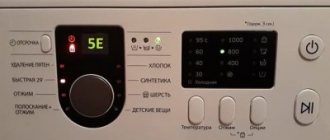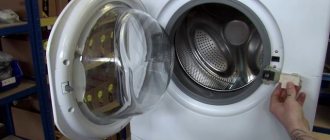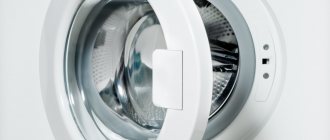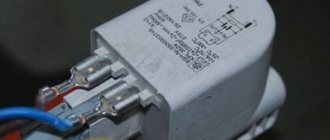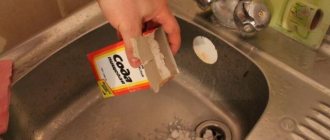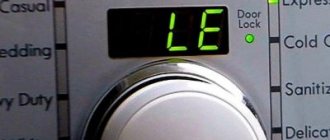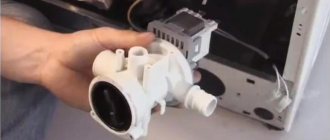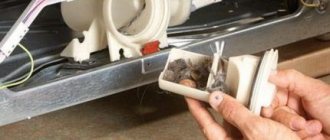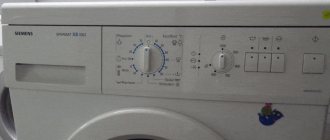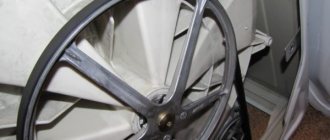Cleaning instructions
Washing machines have two debris filters: inlet (inlet) and drain (drainage). The first one purifies the water coming from the water supply into the machine from the impurities it contains (rust, sand, etc.). The second prevents small items that might have been loaded into the washing machine along with laundry from getting into the drain pump.
If there were no drain filter, the drain pump would instantly fail, and blockages would appear in the drain hose.
You can clean the garbage filter yourself; there is no need to call a professional for this. Follow the instructions clearly, this will help you avoid various troubles: from a dirty puddle on the floor to bringing the machine into a completely faulty state.
The first question that arises is: where is the filter on the Kandy machine? It can be found at the bottom - in the front left part of the case. It is covered by a special camouflage panel or a hinged lid, directly behind which there is a hatch. Having found where the filter is located, you need to follow these steps sequentially:
- To gain access to the location you need, move the machine and lift it slightly if necessary. Remove the decorative panel or open the hatch cover. To do this, it is convenient to use a wide knife or a flat-head screwdriver. The closing element is pulled towards itself or moved to the side.
- In washing machines, only in the drum there is no water at all. A small amount of liquid always remains in the system. When dismantling the filter, it will spill out, so place a container under the hole and cover the floor with a rag. If there is an emergency hose, remove it and drain the water.
- Remove filters. To remove the inlet filter, you just need to unscrew the hose; the mesh can be cleaned without removing it, or carefully pulled out using tweezers. The drain filter is closed by a plug; it must be unscrewed. Unscrew the screw fasteners with a screwdriver and pull out the filter completely.
- Clean the filter. Remove large fractions of debris from the filter, rinse the mesh under running water. To prevent rubber seals from becoming deformed, rinse with warm water, not hot.
- Using a flashlight, examine the filter hole and pump pump. Clean the impeller from dirt and objects that have fallen into it. The impeller should rotate freely.
- Place the pump filter in place by carefully assembling it and tightening all screws.
- Test the machine by plugging it in and running the rinse cycle. While the machine is running, carefully observe for leaks. If the machine is leaking, it means something was installed incorrectly.
- Replace the masking panel or close the hatch cover. If the machine was moving, move it to its original position.
How to remove and clean the fill filter
Almost all modern units are equipped with a mesh fill filter. To gain access to it, you need to disconnect the inlet hose from the washing machine, first turning off the water supply tap.
To equalize the pressure, it is best to wait a few minutes and only then unscrew the hose nut.
Before unscrewing the hose, it is necessary to place a small cloth under the fitting so that residual water does not fall on the back wall of the machine or the floor. Using pliers, grab the filter by the protruding part and pull it towards you. After removal, you need to inspect the mesh for dirt, and if necessary, clean it under running water using an old toothbrush.
A clogged inlet filter can be judged by a small pressure or no water flow at all; when you start washing, powder is poured into the tray. In addition, there are washing units equipped with indicators warning of filter clogging.
What to clean with?
Sometimes a situation arises when the filter cannot be cleaned with water alone. This usually happens if a lot of time has passed since the previous cleaning. What to do with a heavily soiled filter?
In this case, use additional funds. Pour warm water over soda and citric acid at the rate of 20-50 g per liter of water. This solution helps remove scale, rust and mucus. Soak the filter parts in it for a maximum of half an hour, then rub with a sponge and rinse with water. If the plaque is insignificant, it can be cleaned with toothpaste or laundry soap.
Instead of soda and citric acid, special solutions that remove rust are suitable.
Can't unscrew
Sometimes it is not possible to unscrew and remove the filter due to various objects stuck in it. Hair, socks and handkerchiefs, coins, beads and other small items during washing can end up in the catcher in front of the pump and plug it. Limescale deposits on the threads, which occur if the filter has not been removed for a long time, can also become an obstacle.
In this case, there are three ways to open the garbage filter. Apply them in turn, proceeding to the next method only if you tried the previous one and it did not help. Before you begin, be sure to unplug the machine and close the valve to prevent water from flowing.
1 way. Use pliers or pliers to unscrew the filter cap. There is a handle on it that you need to try to turn using a tool. Manipulations should be carried out very carefully so as not to break the filter part.
Method 2. Lightly tap the drain pump filter cover several times while tilting the washing machine. This method is suitable when:
- The garbage filter cover does not rotate at all;
- partially rotates;
- It can be unscrewed, but it cannot be removed.
Tilt the machine back and lean it against the wall. Tap the dust filter cover and the housing next to it. If the snag is in small objects that have stopped the desired part, then the knock will cause them to move, and you can unscrew and pull out the filter.
3 way. If the previous two methods were unsuccessful, then you need to completely remove the drain pump. The task is to clean the snail and remove the filter. This method is quite complicated - you need to get to the pump, unhook the pump from the volute and through the resulting hole get to the filter.
The design features of certain models of Kandy washing machines allow the drainage pump to be dismantled through the bottom. If it is easily removed or is absent altogether, then it is easier and more convenient to get the snail with the pump in this way. Putting the machine on its side or simply tilting it in the desired direction and resting it on the wall, remove the bottom and find the pump. It is located behind the filter, that is, in the lower part of the housing.
Where is the drain filter in my washing machine?
Before starting the “operation”, disconnect the SMA from the network and turn off the water supply. Apply the presented methods sequentially; if the previous option did not help, use the next one.
There is a handle on the filter cover or hole plug. Try turning it using pliers or pliers. Be very careful not to break the filter.
The method is suitable for all three problems:
- when the filter does not turn at all,
- spins, but only a quarter or half a turn,
- It unscrews, but does not come out.
Tilt the machine back 45 degrees (it’s better to lean it on the wall) and tap the filter cover and the body next to it with your fist or palm. It is possible that foreign objects (coins, parts of an underwire from a bra, hairpins, socks, etc.) blocking the filter will change their position and will no longer block its unscrewing or pulling out.
Also suitable for all three “troubles” with a filter:
- when the filter does not spin at all,
- turns, but only a quarter or half a turn,
- It unscrews, but does not come out.
The method is complicated, so proceed with it if the first two options did not help remove the drain filter. Your goal is to get to the snail with the drainage pump, disconnect the pump from it (sometimes it’s more convenient to do this by removing the snail glass itself) and clean the filter through the resulting hole.
In modern washing machines with horizontal loading, depending on the design features, you can dismantle the volute with the drain pump using the following three methods.
1. From below through the bottom, if there is access. If there is no bottom or it can be easily removed, then it is most convenient to dismantle the pump using this method. Place the washing machine on its side or tilt it back 45-60 degrees, resting it on the wall. You should look for the pump immediately behind the filter at the bottom edge of the housing.
2. Through the back wall. In such SMs, the drain pump is located closer to the rear wall, so it is very convenient to get to it in this way. The back wall is usually secured with four screws and can be easily removed. This pump design is often found on Ardo brand washing machines.
3. From the front, removing the front panel with the hatch. The most time-consuming, but sometimes the only method. For example, in many Bosch and Siemens models with horizontal loading there is no other way to get to the pump.
You will need to remove the top cover of the machine and the outer clamp that secures the rubber door seal to the front panel. Additionally, you may need to remove the detergent bin, remove the control panel and unscrew the screws that secure the UBL to the front facade with the hatch. Only after these steps can you remove the facade itself, which is usually held on by 3-4 screws.
The general procedure after you have gained access to the pump is as follows:
We suggest you familiarize yourself with How to clean window glass
- Disconnect the power wires from the pump.
- Place a rag or a basin under the snail with the pump, and carry out all further actions over them.
- Using pliers or pliers, remove the clamp that secures the tank drain pipe to the pump and disconnect it from the volute.
- Try cleaning the snail through the drain hole. If you can’t get to the hole or you couldn’t remove objects that block unscrewing and pulling out the filter, continue disassembling the pump.
- Disconnect the clamp that secures the drain hose to the pump and remove the hose from the volute.
- Disconnect the pump assembly from the washing machine body. Typically, the pump assembly with the volute is attached either to the front wall of the machine or to the bottom using several screws or screws.
- Disassemble the pump into pieces by disconnecting the pump itself from the glass (snail). It is attached to the cochlea using screws or latches. In the first case, you need to unscrew the screws (usually 3 pieces), in the second, turn the pump counterclockwise so that the latches come out of the grooves.
- Clean the pump glass through the resulting hole.
After cleaning, the drain filter should be easy to unscrew or pull out.
Debris gets into the washing machine, from hair to coins, buttons, and metal fragments of clothing. Usually, all this ends up in the drain filter and remains there. In order for the washing machine to work without problems, it is worth periodically cleaning and rinsing.
The signal for this action is often the appearance of noise during washing, poor water drainage, and on some machines there is even a separate sensor on the panel that will light up if there is a need for cleaning.
Most machines have a fairly simple design of filter tanks, and anyone can do the cleaning themselves. Each washing machine has a round or rectangular cover at the bottom (sometimes, to get to the filter, you need to remove the decorative bottom panel), opening which gives access to the filter.
Remember that the filter contains residual water that will flow out when unscrewed, so prepare rags to place under the filter. Or tilt the machine, secure it in this position, and place a container or bag under the flowing water.
Procedure:
- Unscrew the filter counterclockwise. Due to contamination, it may be difficult to unscrew; you will have to apply some effort, and it will give in. If it is secured with additional bolts, remove those bolts first.
- Rinse under running water.
- We check the condition of the tank (it is advisable to use a flashlight) in which the filter is located. Often the channels in it may be dirty; they should be cleaned with a screwdriver or other improvised means.
- We check if anything is stuck under the drain pump blades and, if necessary, remove this debris.
- We twist it back.
If, after cleaning, the reason why you decided to take this action has not disappeared: the chattering has not disappeared, the noise has not disappeared, the drainage of water is still not satisfactory, then you need to call a specialist. For example, when the blades are covered with plastic, the debris that gets there cannot be removed in this way.
Cleaning instructions
Washing machines have two debris filters: inlet (inlet) and drain (drainage). The first one purifies the water coming from the water supply into the machine from the impurities it contains (rust, sand, etc.). The second prevents small items that might have been loaded into the washing machine along with laundry from getting into the drain pump.
If there were no drain filter, the drain pump would instantly fail, and blockages would appear in the drain hose.
You can clean the garbage filter yourself; there is no need to call a professional for this. Follow the instructions clearly, this will help you avoid various troubles: from a dirty puddle on the floor to bringing the machine into a completely faulty state.
The first question that arises is: where is the filter on the Kandy machine? It can be found at the bottom - in the front left part of the case. It is covered by a special camouflage panel or a hinged lid, directly behind which there is a hatch. Having found where the filter is located, you need to follow these steps sequentially:
- To gain access to the location you need, move the machine and lift it slightly if necessary. Remove the decorative panel or open the hatch cover. To do this, it is convenient to use a wide knife or a flat-head screwdriver. The closing element is pulled towards itself or moved to the side.
- In washing machines, only in the drum there is no water at all. A small amount of liquid always remains in the system. When dismantling the filter, it will spill out, so place a container under the hole and cover the floor with a rag. If there is an emergency hose, remove it and drain the water.
- Remove filters. To remove the inlet filter, you just need to unscrew the hose; the mesh can be cleaned without removing it, or carefully pulled out using tweezers. The drain filter is closed by a plug; it must be unscrewed. Unscrew the screw fasteners with a screwdriver and pull out the filter completely.
- Clean the filter. Remove large fractions of debris from the filter, rinse the mesh under running water. To prevent rubber seals from becoming deformed, rinse with warm water, not hot.
- Using a flashlight, examine the filter hole and pump pump. Clean the impeller from dirt and objects that have fallen into it. The impeller should rotate freely.
- Place the pump filter in place by carefully assembling it and tightening all screws.
- Test the machine by plugging it in and running the rinse cycle. While the machine is running, carefully observe for leaks. If the machine is leaking, it means something was installed incorrectly.
- Replace the masking panel or close the hatch cover. If the machine was moving, move it to its original position.
What to clean with?
Sometimes a situation arises when the filter cannot be cleaned with water alone. This usually happens if a lot of time has passed since the previous cleaning. What to do with a heavily soiled filter?
In this case, use additional funds. Pour warm water over soda and citric acid at the rate of 20-50 g per liter of water. This solution helps remove scale, rust and mucus. Soak the filter parts in it for a maximum of half an hour, then rub with a sponge and rinse with water. If the plaque is insignificant, it can be cleaned with toothpaste or laundry soap.
Instead of soda and citric acid, special solutions that remove rust are suitable.
Can't unscrew
Sometimes it is not possible to unscrew and remove the filter due to various objects stuck in it. Hair, socks and handkerchiefs, coins, beads and other small items during washing can end up in the catcher in front of the pump and plug it. Limescale deposits on the threads, which occur if the filter has not been removed for a long time, can also become an obstacle.
In this case, there are three ways to open the garbage filter. Apply them in turn, proceeding to the next method only if you tried the previous one and it did not help. Before you begin, be sure to unplug the machine and close the valve to prevent water from flowing.
1 way. Use pliers or pliers to unscrew the filter cap. There is a handle on it that you need to try to turn using a tool. Manipulations should be carried out very carefully so as not to break the filter part.
Method 2. Lightly tap the drain pump filter cover several times while tilting the washing machine. This method is suitable when:
- The garbage filter cover does not rotate at all;
- partially rotates;
- It can be unscrewed, but it cannot be removed.
Tilt the machine back and lean it against the wall. Tap the dust filter cover and the housing next to it. If the snag is in small objects that have stopped the desired part, then the knock will cause them to move, and you can unscrew and pull out the filter.
3 way. If the previous two methods were unsuccessful, then you need to completely remove the drain pump. The task is to clean the snail and remove the filter. This method is quite complicated - you need to get to the pump, unhook the pump from the volute and through the resulting hole get to the filter.
The design features of certain models of Kandy washing machines allow the drainage pump to be dismantled through the bottom. If it is easily removed or is absent altogether, then it is easier and more convenient to get the snail with the pump in this way. Putting the machine on its side or simply tilting it in the desired direction and resting it on the wall, remove the bottom and find the pump. It is located behind the filter, that is, in the lower part of the housing.
What to do if the drain filter cannot be removed
If you cannot unscrew the drain filter with normal force, then it is better to disassemble the entire pump unit. The reason for its blockage can also be an object that has fallen into its cavity, and without removing the pump, it will not be possible to remove it from there. To troubleshoot the problem you must:
- Disconnect the washing machine from the power supply and water supply;
- Remove protective decorative elements and provide access to the drain pump housing;
- Unscrew all the bolts, nuts and screws that secure the drain pipe and pump to the body of the washing unit;
- Loosen and push back the clamps securing the drain pipe and drain hose to the pump body;
- Remove the pipe and hose;
- Inspect the filter cavity through the pipes, and if there are foreign objects, remove them.
In order to remove a stuck object, sometimes it is enough to simply shake the pump, and the button or paper clip stuck there will fall out through the hole in the nozzle. Otherwise, you can use a screwdriver or tweezers.
Why can’t I unscrew and remove the filter?
The main enemy of all mechanical parts of a washing machine is water with detergents and salts dissolved in it. During operation, under the influence of temperature, these substances are deposited on the walls of all elements involved in the washing process. This, in turn, disrupts their work. If the filter elements have not been unscrewed for a long time, salts deposited on the threads of the filter housing and drain pipe can cause them to block. The part may also not unscrew if there is a foreign object between its body and the impeller.
All the ways to open and remove the drain filter
To remove the drain filter from the drain pipe, sometimes you can do without removing the pump. If the filter can be unscrewed at least half a turn, you should try to unscrew it “back and forth” with gentle movements. If the body is blocked by scale, then it is destroyed, and then this method works. If some “trifle” gets in the way, its position in the body may change and the part can be unscrewed.
Why can’t I unscrew, remove and remove the filter?
The main reason is foreign objects. Lint, wool, hair, small foreign bodies, handkerchiefs, napkins, socks fall into the trap in front of the pump and tightly block its movement in the cochlea.
More rarely, removing the washing machine filter is made difficult by scale deposits on the threads. It forms if it has not been cleaned for a long time.
We recommend! Once every 2-4 months, clean the filter from debris and foreign objects. Detailed instructions are in the article “How to clean the filter in a washing machine.”
Types of filters and their purpose
The normal functioning of the washing machine is ensured by two main and one additional filter:
- mesh filter element of the filler pipe;
The inlet filter is an ordinary metal or polymer mesh with cells of a few tenths of a millimeter, designed to block the path of small particles of plumbing debris into the washing system.
Most often, the inlet mesh element becomes clogged, since it is installed directly at the water inlet into the washing machine.
- drain filter;
The drain filter (main) is a round, oblong plastic plug screwed into a volute designed to protect the drain pump impeller from foreign objects in the form of: toothpicks, matches, buttons and the like.
- water filter for water softening (purchased and installed separately)
The plumbing systems of our apartment buildings leave much to be desired, so the water entering the washing machine may contain pieces of rust, sand and other small particles, the penetration of which into the washing unit is extremely undesirable. Such an abrasive can not only have a negative effect on the mechanical part of the washing machine, but can also lead to damage to things. In addition, rust stains that appear from rust are sometimes completely impossible to wash off.
What to do if none of the methods helped
This means that the washing machine filter cannot be removed due to scale or lime deposits from hard water. Follow the following steps one by one to resolve the issue. This will help minimize possible costs for new parts.
- the glass, soak the glass with the filter in a solution of water and citric acid to dissolve the lime. Or run a preventive wash with lemon juice if you have not yet had time to disassemble the pump. For soaking, you will need a container in which a glass with a filter is placed so that it is completely under water. Pour hot water, but not boiling water, in the region of 40-60°C to reduce the likelihood of damage to the plastic parts of the assembly and the rubber filter gasket. Pour about a tablespoon of citric acid onto the basin. You may need to weigh down the snail with the filter with something so that it does not float up after filling the container with water. Leave the filter to soak for 1-2 hours, then try to unscrew it. It’s not a fact that it will work, but if it works, you’ll save on new parts. The only thing that can be damaged is the rubber filter gasket. Acid can damage it, and then it will need to be replaced. A sure sign of gasket damage is leakage from the filter after reinstallation.
- Try to carefully break the filter out of the snail and install a new one . The plastic is quite fragile and can be cut with wire cutters, and then unscrewed and cleaned out the remains. Proceed carefully, do not damage the thread of the glass (snail). Otherwise, you will need to replace the entire snail, not just the filter. With damaged volute threads, the new drain filter will leak.
- Replace the snail assembly with filter . Immediately, if you don’t want to bother with unscrewing, or when you couldn’t carefully break off the filter. This will cost more than buying a gasket or a new catch filter. But replacement guarantees that the filter will not leak after installation.
If you read the article and realized that removing the washing machine filter yourself is an impossible task for you, then entrust this work to the RemBytTech specialists.
Competent service for washing machines in Moscow and the Moscow region
The RemBytTech service has been servicing and repairing all brands and types of automatic washing machines since 2003. We work at the client’s home, we know how to properly remove the filter from a horizontal and vertical loading washing machine. We service brands: Samsung, Bosch, Electrolux, LG, Zanussi, Indesit, Atlant, Vestel, Kandy and many others.
See the table for service prices by brand.
| Washing machine brand | Cost* (work only) |
| Visit of the master | For free |
| Bosch washing machine | from 1200 rub. |
| Washing machine Indesit | from 1000 rub. |
| Samsung washing machine | from 1500 rub. |
| LG washing machine | from 1400 rub. |
| Ariston washing machine | from 1000 rub. |
| Washing machine Candy | from 1300 rub. |
| Electrolux washing machine | from 1200 rub. |
| Washing machine Zanussi | from 1200 rub. |
| Miele washing machine | from 1500 rub. |
| Whirlpool washing machine | from 1500 rub. |
| BEKO washing machine | from 1100 rub. |
| Washing machine Siemens | from 1500 rub. |
| Washing machine Ardo | from 1100 rub. |
| Washing machine AEG | from 1400 rub. |
| Brandt washing machine | from 1100 rub. |
| Washing machine Atlant | from 1000 rub. |
| Washing machine Gorenje | from 1400 rub. |
| Hotpoint Ariston washing machine | from 1500 rub. |
| Other brand | from 900 rub. |
* Tariff for work. Replacement parts are paid additionally if the service technician finds broken parts during service or damages them when removing the filter (of course, with your consent). The tariff and price of spare parts are affected by the year of release of the SMA, model and brand.
Call "RemBytTech" by phone:
We arrive upon request on the day of submission or the next. If you are not comfortable with service on these days, please provide a different date.
Features of location in different washing machines
In most machines, the filters are located approximately the same - at the bottom of the front panel behind a plastic round or rectangular cover, sometimes behind a decorative panel.
How to clean the drain hose in a washing machine.
Just in case, we will describe the features of the location of drain filters from different manufacturers:
- For Samsung, Candy, Ardo, Hotpoint Ariston, Atlant and LG, the drain tank is usually located at the bottom of the front side. Most models simply do not have a bottom panel.
- For Bosch, Siemens, AEG it is located at the bottom of the front panel, to access it you need to remove the entire bottom panel.
- Electrolux, Zanussi. For these companies it is located at the back. To access it, unscrew the back panel.
- In Indesit, the drain tank is hidden behind the front panel in the lower right corner.
How to make powder for an automatic washing machine with your own hands.
So that the machine serves you for a long time and there are no problems in its operation,
We suggest you familiarize yourself with which products can and cannot be washed in a washing machine
Cleaning mechanisms right away is much easier than removing old dirt.
Do not forget about prevention, which should be carried out at least once every six months, and preferably every three months. Use good powders and before starting the wash, check that the zippers are closed and there are no foreign objects.
If you follow these rules, your machine will serve you for many years.
